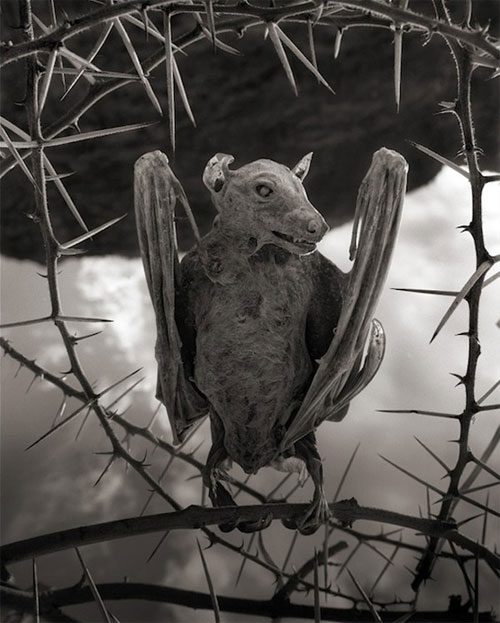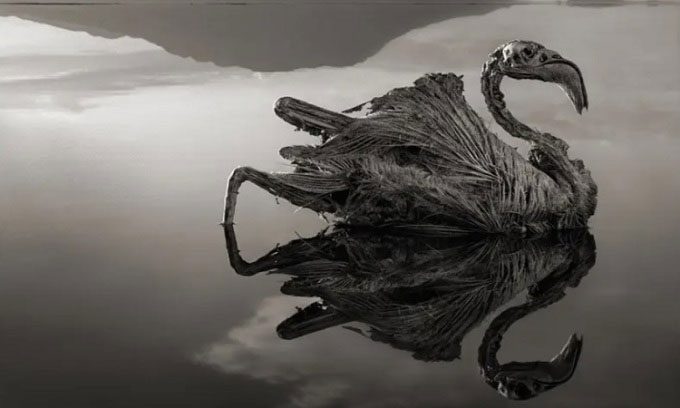Creatures that come into contact with the waters of Lake Natron struggle to survive and become frozen statues.
You don’t need to watch science fiction films to witness living sculptures “transformed” by the deadly waters of Lake Natron (Sodium Carbonate Lake), which also serve as some of the most realistic natural artworks captured by a renowned photographer.
Lake Natron is a saltwater lake located in northern Tanzania, near the Kenyan border. It is one of the most famous lakes, known for its stunning bright red color. However, it is more widely known by the ominous name “Lake of Death.” The reason for this deadly title is that for thousands of years, any creature that accidentally falls into the lake is quickly turned to stone.
Nick Brandt is a famous photographer from East Africa, known for his natural landscape works. During his trip to Tanzania, he had the opportunity to visit Lake Natron. According to photographer Nick Brandt, the waters of Lake Natron are anything but ordinary.

In fact, Lake Natron is a stagnant body of water where evaporation occurs without any exchange with the outside. The lake contains a chemical called Natron – a mixture primarily composed of Sodium Bicarbonate (NaHCO3) and Sodium Carbonate (Na2CO3). This substance enters the lake through eroded materials from surrounding hills. Since the water can only evaporate and not escape, the alkalinity of the lake is extremely high.
With a pH level of around 9 – 10.5 and water temperatures that can reach up to 140°F (60°C), it is believed that Lake Natron is not an ideal home for animals. Moreover, they could lose their lives at any moment if they accidentally step into the water.
The “culprit” behind the strange phenomenon at Lake Natron is a one-million-year-old volcano, named Ol Doinyo Lengai, located south of Lake Natron. The lava from the volcano flows down, carrying special mineral salts. The bodies of animals that fall into the lake are well-preserved, encased in layers of salt cement.
Research indicates that the chemical combination of the substances in the lake is what causes creatures such as birds and bats to become petrified.
According to information from Young Scientist magazine, photographer Brandt has collected these “living statues” around the lake. After gathering them, he placed them on tree branches to set the scene for his artworks. With his artistic eye, the talented photographer has brought the lifeless bodies of creatures back to life.
Only flamingos, who feed on nutrient-rich blue-green algae in the water, flock to this area to mate. However, even they cannot escape the harsh conditions of the lake, becoming victims encased in salt cement.

A petrified flamingo at Lake Natron. (Photo: Nick Brandt).
“I found many creatures like birds and bats washed up along the shores of Lake Natron. No one knows exactly how they died, but the soda and salt content in the lake is too high; it stripped the emulsion off my Kodak film canister in just a few seconds,” photographer Nick Brandt shared in his book about the lake.
In addition to animal remains, Lake Natron also preserves a history of 19,000 years. Immediately after footprints were imprinted in the wet mud and ash, the sediment dried and hardened, according to Dr. Cynthia Luitkius-Pierce, a geologist at Appalachian State University. The mud layer preserving the footprints is believed to have flowed down from the Ol Doinyo Lengai volcano along with a large amount of ash. The surface dried within days or even hours, preserving the footprints. This mud layer holds traces of our human ancestors, their activities, and behaviors during the Holocene along the shores of Lake Natron.
Now, let’s pose a question: What would happen if we accidentally fell into this “lake of death”?
Recently, the YouTube channel What If created a video explaining what would happen if a human came into direct contact with water that could “petrify” any living creature.




















































